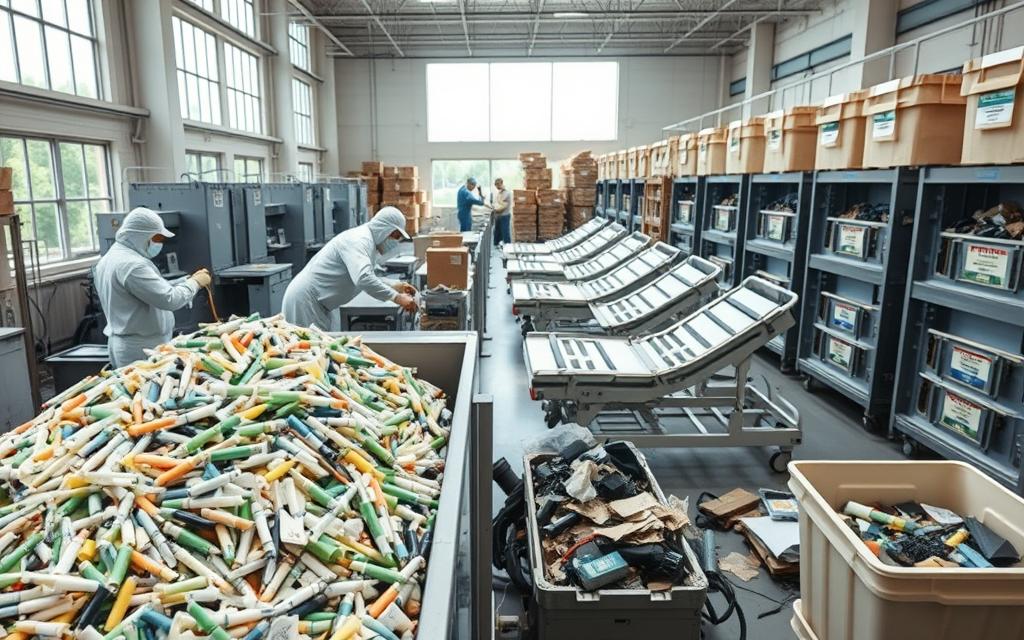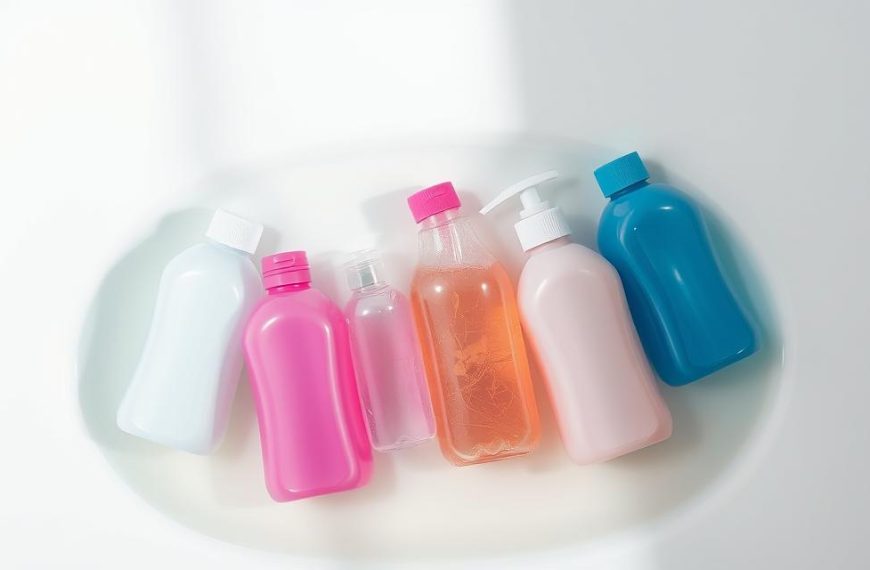Reusing devices offers significant environmental and social benefits. It reduces waste and supports the circular economy, ensuring resources are used efficiently. This practice also helps underserved clinics access essential tools, improving healthcare outcomes.
Programs like MERP have made a remarkable impact, redistributing over 15,000 pieces of equipment. These initiatives ensure that functional devices reach those in need, reducing unnecessary waste and costs.
This guide is designed for healthcare facilities and private owners looking to responsibly manage their devices. With partners like Medical Waste Pros, a nationwide network ensures proper disposal and redistribution, making the process seamless and impactful.
Introduction to Recycling Medical Equipment
Properly managing used devices can significantly reduce environmental harm. When surplus items end up in landfills, they contribute to pollution and waste. Reusing functional tools not only minimizes this impact but also supports the community by providing essential resources to those in need.
Programs like MATTER have made remarkable strides in this area. By redistributing over 10,000 pieces of equipment, they’ve helped underserved clinics access vital tools. This approach reduces healthcare costs and ensures resources are used efficiently.
Before any item is reused, it must meet HIPAA-compliant sanitation requirements. This ensures safety and confidentiality, making the process reliable and secure. Practices also benefit financially, as they can choose between resale or donation options.
“Turning unused tools into valuable resources creates a positive impact on both the environment and healthcare access.”
Partnering with certified recyclers, such as Medical Waste Pros, ensures proper disposal and redistribution. Their nationwide network makes the process seamless and impactful, supporting sustainability and improving healthcare outcomes.
Identifying Recyclable Medical Equipment
Not all devices are suitable for redistribution, making proper identification essential. Understanding which items can be reused ensures they are handled responsibly, reducing waste and supporting community needs.
Types of Devices You Can Reuse
Many functional tools can be repurposed, including electronic monitors, wheelchairs, and surgical instruments. These items often meet the criteria for redistribution after thorough inspection. Programs like MERP require professional evaluation to ensure safety and functionality.
Assessing the Condition of Your Devices
Before any item is reused, it must undergo a detailed assessment. This includes:
- Functionality tests for electronic components to ensure they operate correctly.
- Cosmetic evaluation to determine eligibility for donation or resale.
- Manufacturer take-back programs for faulty devices, ensuring proper disposal.
Organizations like the Stavros Center offer a dedicated helpline (800-804-1899) for condition evaluations. Additionally, UPMC Horizon follows strict sanitation standards to ensure reused items are safe and reliable.
“Proper assessment transforms unused tools into valuable resources, benefiting both the environment and healthcare access.”
By partnering with certified service providers, you can ensure that functional devices are redistributed efficiently. This approach not only reduces waste but also supports underserved communities.
How to Recycle Medical Equipment: Step-by-Step Process
Responsibly managing surplus healthcare tools ensures environmental and community benefits. Programs like MERP and GotDME provide structured solutions for redistribution and proper disposal. Whether you’re handling large or small devices, following these steps ensures efficiency and compliance.
Large Devices
For larger items like wheelchairs or hospital beds, start by assessing their condition. Ensure they are functional and meet sanitation standards. Organizations like MERP accept canes and walkers, making it easy to donate or redistribute these items.
Use the GotDME database to locate local recyclers. Simply enter your ZIP code to find nearby drop-off locations. This streamlined process ensures your devices reach those in need without hassle.
Small Devices
Smaller items, such as glucose monitors, often have mail-back programs. For example, Medtronic’s TakeBack initiative allows you to return devices safely. Always remove batteries from digital thermometers before disposal to prevent environmental harm.
Certain items are banned from curbside recycling. These include nebulizers, insulin pumps, CPAP machines, and pulse oximeters. Partnering with certified services like Medical Waste Pros ensures proper handling of sharps containers and other restricted items.
“Proper redistribution transforms unused tools into valuable resources, benefiting both the environment and healthcare access.”
By following these steps, you can ensure that functional devices are reused responsibly. This approach reduces waste, supports underserved communities, and promotes sustainability.
Donation Options for Functional Medical Equipment
Donating functional devices can transform lives and strengthen communities. Programs like MERP have helped over 10,000 patients access affordable care. These initiatives ensure that unused tools reach those who need them most.
Finding Local Donation Centers
Local service centers make it easy to give away surplus devices. Organizations like The Hospital Bed Project in Southern New England have successfully redistributed hospital beds to underserved areas. These efforts highlight the power of community-driven solutions.
Insurance loopholes often leave people without access to durable devices. Donations bridge this gap, ensuring that everyone has the tools they need for better health. Here’s how donations make a difference:
- Reduced hospital readmissions: Access to functional devices improves recovery outcomes.
- Improved chronic disease management: Tools like glucose monitors help patients manage conditions effectively.
- Increased mobility: Wheelchairs and walkers restore independence for many individuals.
- Lower healthcare costs: Donations reduce the financial burden on clinics and patients.
Benefits of Donating to Low-Cost Clinics
Free clinics rely heavily on donated devices. In fact, 73% of their patients depend on these resources for care. Your contributions can directly impact their ability to provide essential services.
MERP, for example, refurbishes wheelchairs at a cost of $150 per unit. This investment ensures that devices are safe, functional, and ready for use. By supporting such programs, you’re helping people in need while promoting sustainability.
“Every donation creates a ripple effect, improving lives and strengthening communities.”
| Benefit | Impact |
|---|---|
| Reduced Readmissions | Improves recovery outcomes |
| Chronic Disease Management | Helps patients manage conditions |
| Increased Mobility | Restores independence |
| Lower Costs | Reduces financial burden |
Conclusion
Turning unused healthcare tools into valuable resources creates a lasting impact. Programs like MERP have successfully redistributed over 15,000 devices, ensuring they reach those in need. This effort not only reduces waste but also supports underserved communities.
If you have surplus items, consider contacting MERP at 724-347-6377 or Medical Waste Pros at 888-755-6370. These services ensure proper disposal and redistribution, benefiting both the environment and healthcare access.
Signs indicating an urgent need for action include equipment upgrades, facility closures, and manufacturer recalls. By addressing these promptly, you contribute to a sustainable future. As MERP says, “Your old equipment becomes someone’s new independence.”
For more insights, visit MediGroup’s guide on transforming unused tools into valuable resources.

















